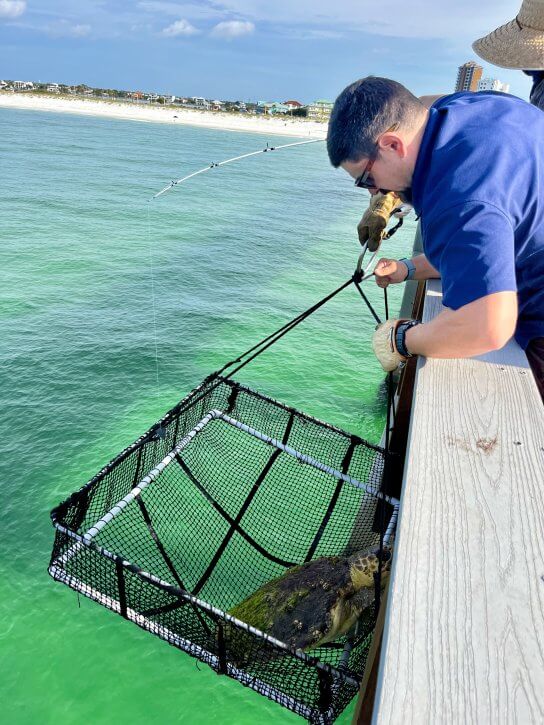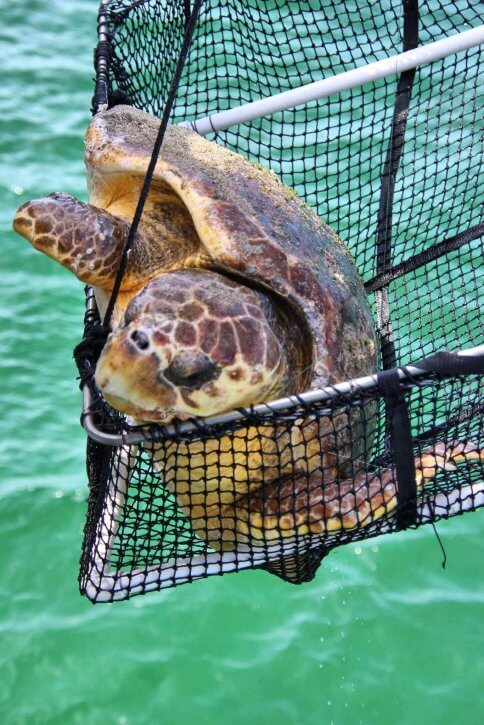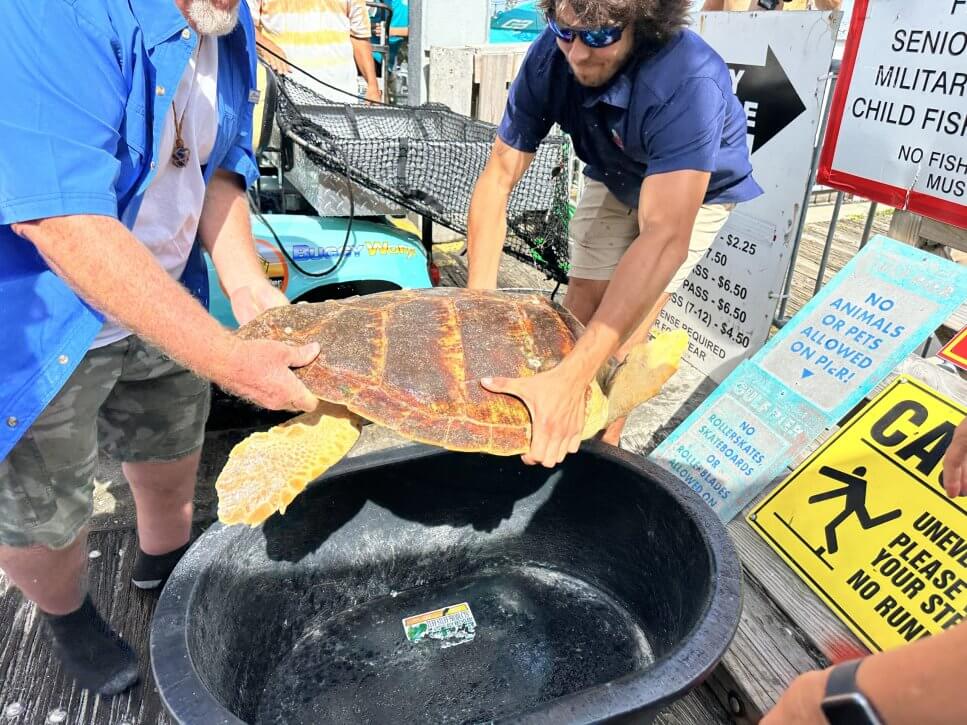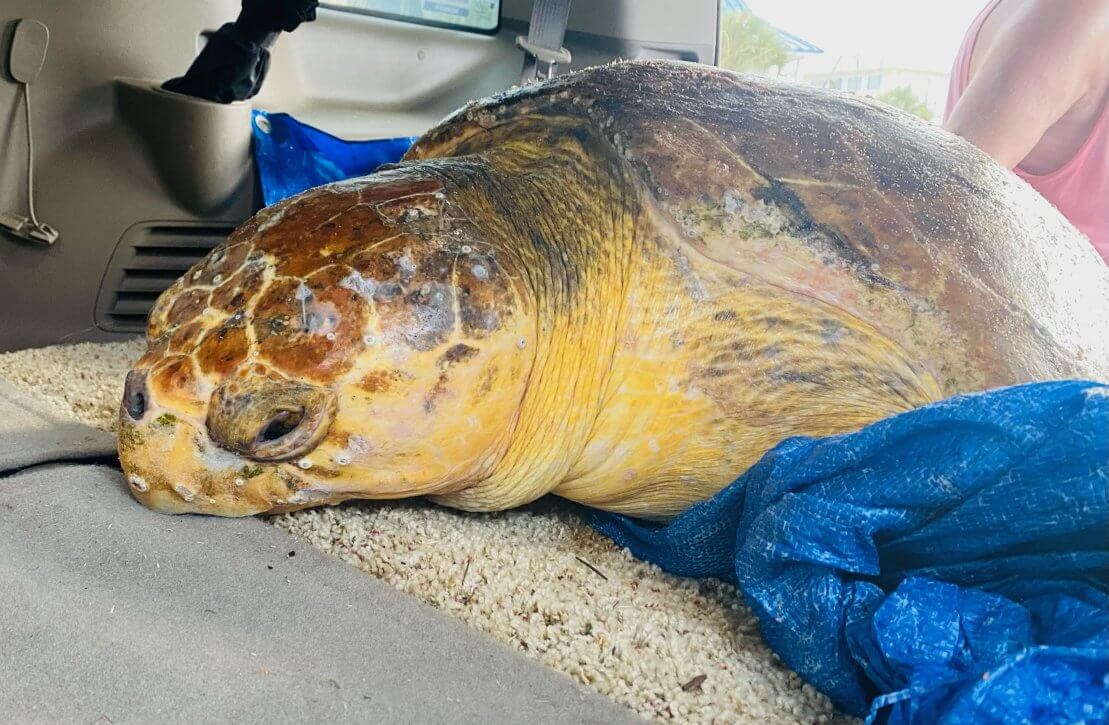
Summer is sea turtle nesting season along the Gulf Coast. From May to October, county, state and national park volunteers patrol the beaches each morning looking for tracks that indicate that a female turtle has come ashore and laid a nest. Each nest is roped off and monitored to ensure that the hatchlings have the best chance of making it to the Gulf. Since turtles stay closer to shore in the summer for nesting and mating purposes, they are also more prone to stranding and being accidentally hooked near piers and shore fishing spots, so in addition to morning nesting patrols, one of the area’s biggest initiatives for turtle safety relates to rescuing these stranded or hooked turtles. Beach residents, locals, and tourists alike share a love for these endangered animals, and a new nonprofit group is working to strengthen the protection already offered to marine turtles.
Gulf Coast Turtle Watch (GCTW) 501(c)(3) nonprofit was established in early 2024 by founders Wendy Hoeflich and Stephenie Allen, both longtime volunteers with Escambia County Marine Resources (a branch of the Escambia County Natural Resources Management Division) for morning nesting patrols. Local government environmental programs and the National Park System are tasked with many different conservation efforts, and various programs depend on dedicated volunteer effort and work within very tight budget constraints. GCTW was formed in large part to provide support to the existing programs dedicated to marine turtle conservation and protection. Though the initial focus is on the Pensacola Beach area, there are future plans to connect with other county and national park organizations doing turtle work throughout the Gulf Coast, as the group’s name suggests. This collaboration and connectivity will aid in fundraising efforts, grant writing, community education, etc. Currently, the Board of Directors consists of both Hoeflich and Allen along with Dale Hensley and Christine Brewster.

Though the group is new, Hoeflich notes that beach businesses, especially those surrounding the Pensacola Beach Gulf Pier, and beach residents have been incredibly excited and supportive, and support for the group has grown faster than expected. Pier owner Mike Penzone, his son Devin, pier staff, and the Pensacola Beach Lifeguards have been especially proactive in initiatives and education to help turtles who are hooked near the pier. When a turtle swallows a hook, chances are that the turtle is a “repeat offender;” 60-70 percent of hooked turtles have been hooked before after recognizing the pier as a place to get an easy meal. Additionally, when a turtle washes ashore, it is usually because the turtle has ingested plastic, hooks, filament, or other materials that have made it difficult for the turtle to eat and swim regularly. Hooked or stranded turtles may be suffering from anemia and will only continue to get sicker. Florida Fish and Wildlife Conservation Commission (FWC) standards indicate that any turtle that is hooked or stranded should receive medical attention, even if it is not suffering from an obvious injury like a boat strike. The closest sea turtle hospital and rehabilitation facility is the Gulfarium’s C.A.R.E. Center (Conserve, Act, Rehabilitate, Educate) located in Destin, and if the C.A.R.E. Center is at capacity, then turtles must be transported to the Gulf World Marine Institute in Panama City Beach.
Currently, permitted volunteers have stepped up to transport turtles in their own vehicles and at their own expense, and transport protocols plus the size of marine turtles often pose difficulties in addition to the sheer number of calls received.
“It’s normal for us to receive several calls a week about hooked or stranded turtles, which is actually a good problem to have,” says Hoeflich, “because it means that we’ve built solid relationships with pier staff and fishermen, and they know to call us rather than simply cutting the line, risking further injury to the turtle.”

Turtles cannot be transported without cover from sun exposure and dehydration, so pickup trucks are not eligible vehicles. Additionally, fully grown turtles can be well over 200 pounds and require enough space to ride comfortably in a transport bin, so permitted volunteers with large vans or SUVs are called upon again and again for transport. Thus, one of GCTW’s immediate initiatives is to raise 20k in order to purchase a large transport van that would remain parked at the pier and to which many trained and permitted volunteers would have access. Currently, the group has raised about 20 percent of that goal, and additional funds would go into wrapping and maintaining the vehicle, insurance, and fuel costs. GCTW kicked off their fundraising efforts in June with Sea Turtle Sips, a guest bartending and silent auction night at The Islander featuring coastal art donated by local artists and GCTW swag. Future fundraising efforts include working with beach businesses to institute “round up” programs where patrons can choose to round up their purchases to the nearest dollar, and those extra cents would be then donated to GCTW. Though an official website is still in the works, the group’s Facebook page features a donate option and offers magnets, t-shirts, stickers, etc. for sale.

Once enough funding for the transport van has been secured, GCTW plans to focus on furthering lighting initiatives; turtles who come ashore at night to nest are disoriented by artificial lighting, flashlights, and cellphone lights, but they are unaffected by amber and red lights. Though there is a turtle-safe lighting ordinance in place for all water-facing businesses, hotels, condos and homes, it is difficult to enforce every violation, and public education and awareness goes a long way in helping to ensure ordinance compliance. Small things like keeping blinds and curtains closed at night and using red turtle-safe flashlights on the beach at night can go a long way in eliminating disorienting light exposure for nesting mothers and hatchlings. GCTW plans to work with Escambia County Marine Resources to get informative refrigerator magnets and window clings in all rental units that inform renters and tourists about safe lighting practices and ‘Clean, Dark, Flat’ initiatives that aim to keep the beach free of holes, trash, sandcastles and other obstacles that may deter nesting turtles.
If you’d like to learn more about the GCTW and its efforts to support county programs and marine turtle work in our area, you can connect with volunteers every other Tuesday at Bands on the Beach. Escambia County Natural Resources graciously shares its booth space with GCTW, and volunteers are out every other week to answer questions, spread awareness, and even give away red ‘turtle-safe’ flashlights for evening beach walks. You can also visit Gulf Coast Turtle Watch on Facebook to donate and purchase merchandise (send a message to view available merchandise).